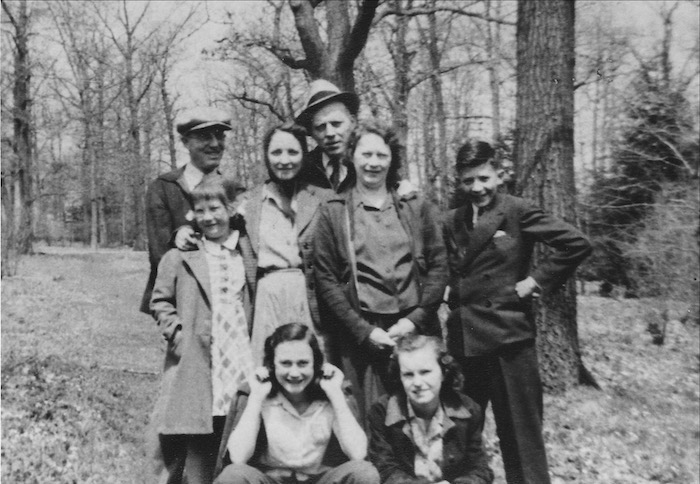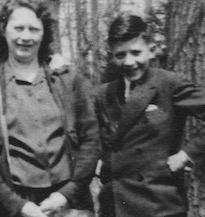This is a summary of my research into the roots of my Muster and Moldenhauer ancestors. It's a chronological biography, not a memoir. But if you're searching for Musters and Moldenhauers, I have lots more information already posted on this site. Moldenhauer | Muster
Before I did this research, nobody in our family knew my father was named after his father. Nobody knew my father's grand-father fought in the Civil War. It was all just a mystery.
My stepfather got me interested in family genealogy and I went on to find my father's mother's family and his father's family. In my sixties I put it all together and now understand their stories. It began with the Muster family of Valparaiso, Indiana.
Great-grandfather John Muster immigrated from Switzerland in 1859 and settled in Valparaiso just before the Civil War broke out. John could barely speak English but in 1861 he joined the Indiana Volunteers as a Swiss national and listed his language as "Swiss." [*John Muster most likely spoke Schwizerdütsch.]
He started as a private in Company I 20th Indiana Volunteer Infantry. After serving for about a year, the Confederates captured the boat he was on, the Gunboat Fanny, in the Outer Banks of North Carolina. The Confederates put the Yankees in Libby Prison, took control of the boat, and used it to transport Confederate troops and supplies through the rest of the war.
Historian Lee Thomas Oxford researched and wrote a book about the encounter, The Civil War on Hatteras: The Chicamacomico [Chick-cah-mah-com-a-co] Affair and the Capture of the US Gunboat Fanny [*The Civil War on Hattera, by Lee Thomas Oxford was published by The History Press, 2013.]
Lee first contacted me and asked if I knew my great-grandfather was in the Civil War. I told him I did know because I found his grave marker on the Internet. Lee also put me in contact with first cousins once removed who were also doing their Muster ancestry. When Lee's book came out, he tried to organize a reunion of the descendants on both sides of the battle. I wanted to attend, but did not. Lee later told me Hurricane Irene ran the reunion out of town, so I didn't miss anything.
Just three months after being captured and let go, John Muster enlisted again as a corporal in Company I, 5th Cavalry, 90th Indiana Regiment. He fought in Sherman's army at Ringgold, Georgia, in 1864. After that, they sent him to the rear of General Johnston's army to liberate Union prisoners from Andersonville, remembered as the most deadly Confederate prison camp. However, the Confederates captured John and others in Johnston's army, and John spent the rest of the war in Anderson and other Confederate prisions.
According to his obituary, John joined the fraternal organization Grand Army of the Republic (GAR) after the war, and died in 1887 of his war wounds. The obituary described it like this:
Comrade Muster once more became a prisoner and was taken to Andersonville on the 28th day of August. 1864, where he remained a part of the time, also at Florence prison, S. C., without sufficient food to keep soul and body together . . . surrounded by every suffering and hardship that human could endure and live - tortures that pen cannot depict. He remained there until the 7th day of March, when be was liberated and sent north. He was discharged from military service again on the 15th day of June, 1865, having faithfully served his adopted country and flag and endured untold suffering for three long years, eight months, and four days. . . . and was a good and faithful comrade until death removed him from their numbers. His warfare is over, his suffering is ended, and he is united with that great grand army that knows not any parting - he is waiting and watching for the coming of his comrades. [*John Muster obituary, c. 1987.]
After the war John Muster returned to Valparaiso and married Barbara Burkhart. It's possible they met and became friends before the war. When he returned from his military duties, she was nineteen, old enough to get married. He was thirty-seven, but that big age gap runs in the Muster family. It's unsettling, but they're my ancestors. And all this took place more than a hundred and fifty years ago.
My great-grandmother Barbara Burkhart Muster came to America with her parents in 1852. The family lived in Colmar and they left just at the dawn of the Second French Empire. Although they lived in Colmar, the Burkhart family roots were in Schwaben, Bavaria, known as Swabia, which is near Munich.
After coming to America, Barbara lived in the same house the rest of her life. John moved in when they married, and I suppose the farm became theirs when Barbara's parents passed.
The farm house was at 833 Lincolnway. It's gone now, but the old farm house was near the campus of Valparaiso University. The school opened before the Civil War, so it was there when my ancestors lived there. It was a small world for the Muster family. For one thing, the cemeteries where all the Musters were buried are just a mile south of their farm.
Over twenty years of marriage John and Barbara had eleven children. My grandfather, William Newton Muster, was their first child, born in 1868. In 1887, after all their children were born, John died of his war wounds. Barbara remained on the farm.
William remained on the farm for the rest of his life too, and lived just a half mile down the lane from his mother. I can guess he helped his mother manage the farm. In 1891 William married his first wife Esther "Ettie," Harrison. Most likely, she fit right in and the family loved her. Ettie and William were married for about thirty years. I did not find any children for them in the Census records.
At first my grandfather William Muster was a constable, but on January 1, 1902, when the US Postal Service expanded rural delivery to Valparaiso, he worked for the USPS. he was said to be well-liked and delivered the mail in his horse-drawn surrey cart. My grandfather also bred race horses and his horses were successful in competitions around Indiana and surrounding states.
In 1920, Ettie died in the flu pandemic, which must have been a terrible loss for the family. Over the next few years the pandemic subsided to make way for the Roaring Twenties. This is when William met my grandmother, Emma Moldenhauer. They had radically different backgrounds. Emma grew up in Chicago, the big city; William was from a small town and lived a rural life.
The two of them also had a radical age difference. William was fifty-seven and Emma was thirty-nine. That's eighteen years difference, the same age gap between John and Barbara Muster. William and Emma married August 23, 1925.
To me it seems like Emma took Ettie's place in William's house. And they expected life to go on as normal. I found out from my once removed Muster cousins that the family was estranged, and that's why none of our Muster cousins don't know each other. And of the people I have met, nobody knows what divided the family.
Two months into the marriage, according to his obituary, his horse stumbled in a surrey cart race, throwing him under the cart of another driver. William lingered a couple of months and then died. [*William Muster Obituary, "Veteran Rural Mail Man Dies," February 1, 1926]
The Musters buried William next to Ettie in the family graveyard. It must have been a challenging episode for everyone, because six months later, Emma gave birth to William's child, my father. She lived on the farm until 1929, then took her two sons and moved in with her family in Chicago.
When I was kid, my father told me about the South Chicago apartment where he lived with his mother's family. He remembers it as a small, crowded place, with people and dogs. [*The 1930 census located Emma and her family in Chicago at 6218 South Lincoln. That street is gone now, or at least I couldn't find it.]
Later in life I looked into that and found all his relatives in the 1930 Census. It was eight relatives including my dad, and he was the youngest. [*In the 1930 Census, the head of household was my great-grandfather Ernest Moldenhauer, who was seventy-two. The census taker misspelled Moldenhauer and listed my father with the same last name as his half-brother Ed Miller. I had trouble finding the family, but a more experienced ancestry researcher found them in the 1930 Census and sent me the link.]
Dad hardly ever talked about his childhood, or anything about his own life that was more than a year or two ago. But it was still fresh in his mind when he met my mother and told her all he remembered from his childhood "everyone dying." Once I had the relative's names, I could figure out who "everybody" was who died. His grandfather Ernest died July 12, 1930. His grandmother Otila died September 21, 1934. Then his mother, Emma, died October 10, 1934. This left my father orphaned.
His grandmother Barbara Muster died in 1931, but I didn't find any evidence Emma stayed in contact with the Musters, and she did not attend the funeral. One of the obituaries noted that twelve of Barbara's grandchildren attended the funeral, but if my father had been there, he would have been the thirteenth grandchild.
Despite big families on both sides - Muster and Moldenhauer - none of the relatives wanted to adopt my father. Uncle Ed wanted to, but he had a family to support. It was 1934 the Great Depression.
At first Uncle Ed put my dad in an orphanage, but took him out when he heard the orphanage was abusive. After that, Ed registered him with a foster home agency. Growing up, Dad lived with least a half-dozen consecutive foster families in and around Chicago right up to World War II.
In some subconscious repetition of my father's life, I also grew up feeling alienated and abandoned. I even put myself in a foster home-like situation living at Patty B.'s house. The summer after high school I applied for a job at an orphanage. Dad asked me why I would want to work in an orphanage. I could tell it bothered him, and that sense of melancholy haunted him at times.
One important discovery I found was a photo of Grandmother Emma. It was in my father's files. I admire Emma and empathize with what she went through, raising her two sons, and dying so young.

Detail of the family portrait (below) is Emma Mouldenhauer and her son, my father, Bill Muster. This photo is from the early 1930s.

genealogy index
